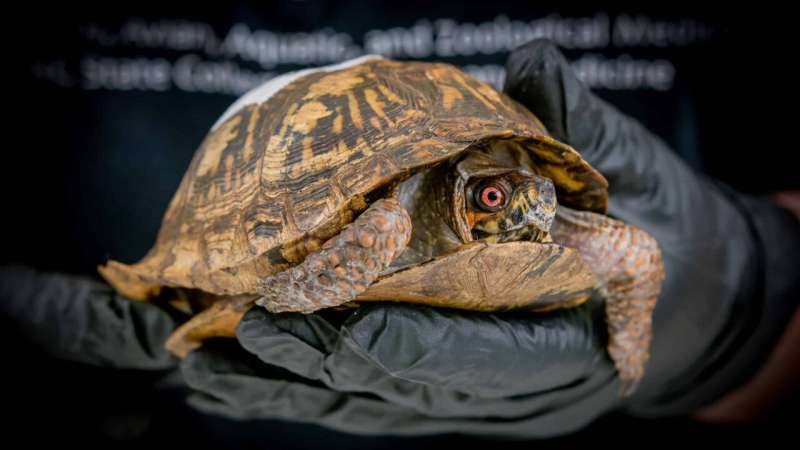This article has been reviewed according to Science X's editorial process and policies. Editors have highlighted the following attributes while ensuring the content's credibility:
fact-checked
trusted source
proofread
Where do rehabbed turtles go?

When a wild turtle recovers from an accident and is released back into the wild, what happens next? A new study from North Carolina State University reveals that finding those answers can often be just as challenging as saving the turtle itself.
NC State's Turtle Rescue Team (TRT) is an all-volunteer operation run by veterinary students that sees over 600 wild turtles, reptiles and amphibians each year. On average, approximately half of the animals admitted each year are successfully treated and then released back into their home environment.
"As a volunteer organization, we don't really have the resources or means to track all of these animals and discover what their health outcomes might be in the long term," says Sarah Zurbuchen, lead author of the study and graduate of NC State's veterinary school. "I wanted to do a pilot study to try and figure out what the survival odds really are for these animals—and what the challenges of trying to track them would be."
Zurbuchen and her fellow TRT volunteers selected 16 turtles for the pilot study.
The turtles were selected based on several logistical parameters: they had to be deemed fit for release by both the rehabilitation coordinators and the turtle's case manager; they had to have been found within one hour's driving distance of the NC State Veterinary Medical Campus to facilitate regular tracking; they had to live on public land or, if on private property, landowners needed to agree to regular tracking of the turtle for the length of the study; and finally, the turtles needed to weigh at least 100 grams to ensure the transmitter was not over 7% of their body weight.
There were no selection criteria based on presenting injury, diagnosis or time spent in treatment/ rehabilitation.
The team attached a radio transmitter to the back of each turtle's shell with a nontoxic waterproof epoxy. The transmitter had a distance of approximately 700 meters, and a battery life of about 280 days. Then the turtles were released. The volunteers tried to ensure that all turtles were released within an approximately one-mile radius of where they were found. Then they attempted to check in on the turtles monthly and record their health information.
There were some immediate challenges.
"The distance on the radio transmitters turned out to be pretty variable when you're using them in hilly or highly forested areas," Zurbuchen says. "We had one turtle that at one point we could not locate using telemetry due to a malfunction, but since he had been released on private property the homeowners were able to find him and give us information.
"GPS trackers would be more exact, but they cost more and have a shorter battery life," Zurbuchen adds. "When you're only doing monthly check-ins you need batteries that can last at least that long."
Of the 16 tagged turtles, three were found deceased within 86 days of release; five were never located after release; three were found once after release but not thereafter; four were successfully tracked until brumation (overwintering in which turtles enter a period of torpor) but were subsequently unable to be located; and one turtle was successfully tracked for the entire study period.
While the study was small, the researchers did make some interesting observations. The turtles that were located moved an average of 100 yards between each observation. The exception was a turtle that was released well outside of his home range, who moved 750 yards over the course of the observation period.
"The dogma is that turtles will wander until returning to their home range, but that was not the case with this turtle," Zurbuchen says. "So maybe he was able to acclimate. But on the other hand, many of the turtles moved much farther than we expected—we had five males we never located at all."
They were unable to determine the cause of death for the three deceased turtles, and the study size makes it impossible to infer whether their injuries played a role.
Zurbuchen thinks that utilizing public involvement to spot and observe the turtles—perhaps by marking them with QR codes that allow people to report sightings—might be a useful tactic in the future, while radio tracking could be used to focus on particular single cases.
"Our main takeaway was that there are challenges, but there are equally creative ways to overcome them," Zurbuchen says. "Our end goal is obviously to discover what happens to these turtles when they leave our care, so that we can do our best to ensure their survival."
The study is published in the journal Wildlife Rehabilitation Bulletin.
More information: Sarah Zurbachen et al, Long-term telemetry study monitoring health parameters and behaviour of eastern box turtles (Terrapene carolina carolina) released from treatment and rehabilitation, Wildlife Rehabilitation Bulletin (2023). DOI: 10.53607/wrb.v41.252
Provided by North Carolina State University




















